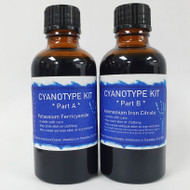CYANOTYPES
Posted by Geoff Watson on 11th Jul 2022
CYANOTYPES
These are also known as “blueprints” or “sunshine prints” .
The process was invented by John Herschel who was born in Slough in 1792. He was educated initially at Eton and then by a private tutor in mathematics before entering St. John’s College Cambridge. Although he became a distinguished astronomer like his father who had discovered Uranus, he also made major contributions to chemistry, physics, mathematics and in particular photography. At Cambridge and in his subsequent career he was a friend of Babbage the pioneer of mechanical computers.
PHOTOGRAPHY
Herschel’s experiments in Photography began when he published details of his research in 1819 and again in 1839,1840 and 1842.After he learned of Daguerre’s achievements, he resumed his interest in photography and was visited by the other British pioneer photographer Fox Talbot. Herschel was able to introduce Fox Talbot to the properties of Sodium Thiosulphate (Hypo) to “fix” silver prints and make them permanent. The very first photographic images were produced by Thomas Wedgewood the son of Josiah the potter in the 1790’s but these were kept in “night books” and viewed only by candlelight as they could not be rendered permanent as Wedgewood did not know of the Herschel’s invention of Sodium Thiosulphate (Hypo)
THE CYANOTYPE PROCESS
This as invented by Herschel in 1841/2 and is perhaps the simplest of all photographic processes. Paper or any other absorbent material is coated with a mixture of Potassium Ferricyanide and Ferric Ammonium Citrate. Exposure to light under an image on translucent material produces a blue image composed of “Prussian Blue” which is made permanent by washing with water.
As well as its use in reproducing photographs the process was used for well over a century to produce copies of engineering and architectural drawings known as “blueprints”
PRACTICAL DETAILS OF CREATING A CYANOTYPE
1). Potassium Ferricyanide and Ferric Ammonium Citrate are dissolved separately in water.
2). The solutions are mixed in subdued light
3).Absorbent material (usually paper or fabric) or coated evenly with a brush or sponge in subdued light.
4). This is allowed to dry thoroughly in subdued light as it is now photo sensitive.
5). A photographic negative, drawing or print on translucent material or object like a fern is placed on the sensitized paper
6). This is best done in a traditional “printing frame” or just sandwiched under a sheet of glass.
7). This is exposed to sunlight to “develop” the image.
8). Exposure time in strong sunlight may take up to a minute, or several minutes in dull weather.
9). When “development” is complete the cyanotype should be washed thoroughly in water
10). It is then allowed to dry,
The image can be deepened by a weak solution of Hydrogen Peroxide or weakened with an alkali like washing soda if desired.
NB There are alternative “Cyanotype” processes using oxalates, but these offer few advantages, and the materials are more costly.
Cyanotype kits are available from Hyperdrug (www.hyperdrug.co.uk) which include the chemicals, a foam coating brush, protective gloves, and full directions.

